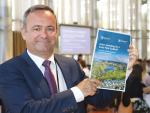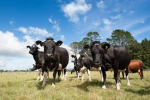Dairy farmers' equity in their farms looks to be staying flat or even declining slightly on average over the next ten years.
So says DairyNZ farm systems specialist Paul Bird, Hamilton.
Bird spoke at a recent SMASH (Smaller Milk and Supply Herds) open day at Takaka, presenting a graph showing the top 25% of farms in the northern South Island could expect equity growth of $1.3 million over 10 years. However, he forecast a slight drop in equity – about $134,000 – on average, which meant the poor performers would be struggling.
Bird said the numbers were based on three years average cost structure, on current debt levels and an estimate of a $6/kgMS milk price -- the last 10 years average.
“But whenever you forecast out, there are always big errors in reality so even though it looks like it’s declining by $100,000 over 10 years, it’s kind of a break-even. So half are doing better, but half are really struggling.”
Bird said farm working expenses are the overriding factor in equity growth so the question for farmers is how to change their cost structure. There is no simple answer but the biggest driver is pasture management and the next-biggest is controlling personal expenses.
“You see people who have good farm cost structure and tight farm management; they have a clear focus on just a few targets on the farm and they are good at monitoring those targets. It’s just basic farm management.
“They home in on those few key things and they monitor them and they hit the targets -- like grass cover and cow condition -- and then they hit pasture-eaten targets and it allows them to have a lower cost structure.”
Bird was speaking at a meeting organised by SMASH, which addresses the concerns and challenges of dairy farmers with smaller herds. The theme of the open day was diversification as a way for small herd farmers to get to where they want to be in 10 years.
But he said the lessons are applicable “absolutely across the board”. “There’s a surprisingly small amount of economies of scale in dairy farming.”
He said aiming for as much pasture-eaten as possible is important, as is low stock wastage and stock replacement rates.
“Farms with low-cost structure tend to have very good reproduction; they require fewer replacements and have higher stock income.”
Bird said DairyNZ’s message is for everyone to be clear about where they want to be in 10 years.
“If it’s your passion and interest to try different things then we would strongly support you to go down that track. But I think the key thing with the numbers is if you’re going to do some different things do them from a strong financial base.
“If you do it from a base where you’re going backwards and under financial pressure.”


















